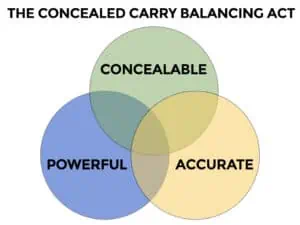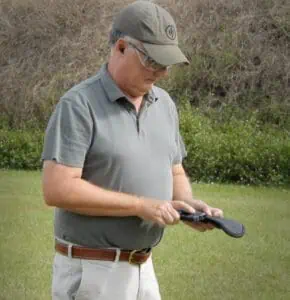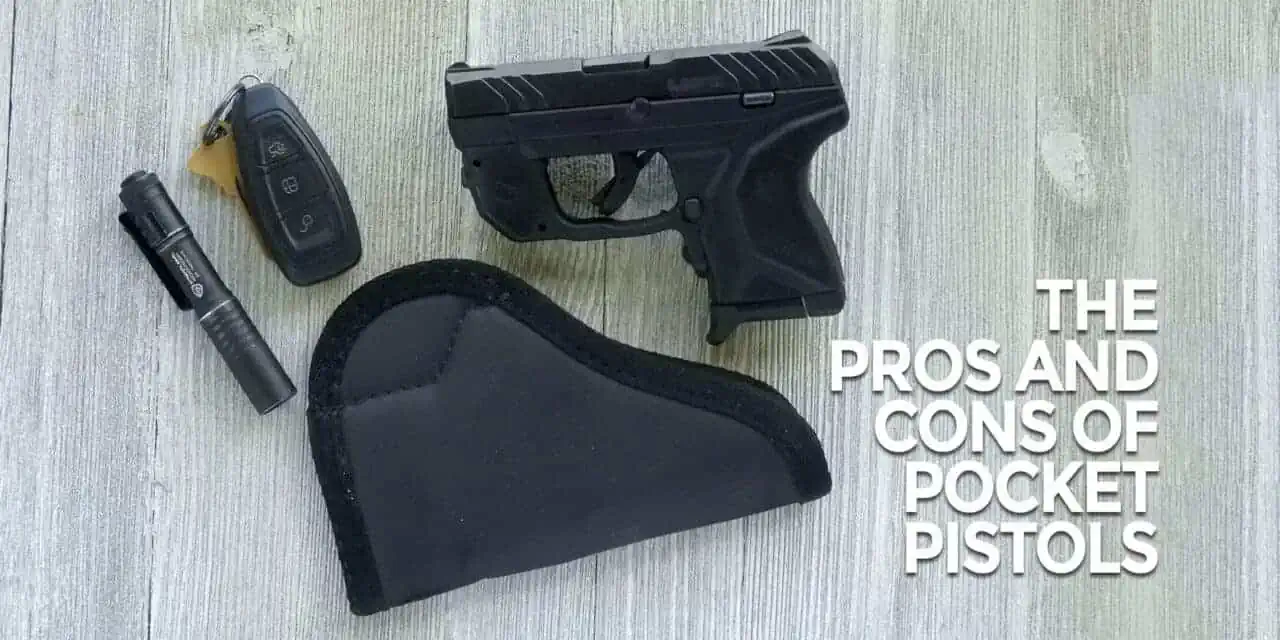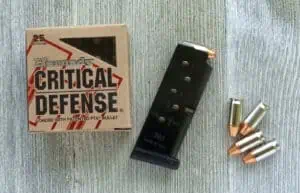Pocket Pistols: A Compromised Solution For Compromising Situations
I worked in an office environment for ten years. There was no prohibition against concealed carry where I worked, but it wasn’t encouraged, either. Given that situation, and the demands to maintain a professional-looking appearance to my clients and co-workers, I found that a pocket pistol was the right solution for me.
But is a pocket pistol the right solution for you? Let’s look at some of the advantages and disadvantages of pocket carry and find out.
Why Use A Pocket Pistol
 Let’s be clear about one thing, right up front. A pocket pistol should not be your primary day in, day out carry. They are not an optimal solution for your concealed carry needs. They are an alternative to your regular carry pistol, and should only be used in rare circumstances when the need to be discreet is paramount. Remember the graphic on the right from the article on choosing your first pistol? A pocket pistol fits on the extreme top of that image. They require drastic compromises with both accuracy and firepower in favor of optimizing concealment.
Let’s be clear about one thing, right up front. A pocket pistol should not be your primary day in, day out carry. They are not an optimal solution for your concealed carry needs. They are an alternative to your regular carry pistol, and should only be used in rare circumstances when the need to be discreet is paramount. Remember the graphic on the right from the article on choosing your first pistol? A pocket pistol fits on the extreme top of that image. They require drastic compromises with both accuracy and firepower in favor of optimizing concealment.
Those compromises show up the minute you take them to the range. Because they are so small and light, the recoil from a pocket pistol can be brutal, even though they tend to fire weaker cartridges. There is just not enough mass in a pocket pistol to soak up the foot/pounds of energy as the bullet leaves the barrel. In addition to this, smaller guns don’t have the grip size of larger guns, giving you less real estate to hang onto as your gun recoils.
What Is A Pocket Pistol?
We should pause a moment and define the term “pocket pistol.” For me, that phrase means one of two kinds of guns. The first is a small, single-stack semi-automatic in a centerfire cartridge, usually .380ACP. The second is a short-barreled revolver, aka “snubby,” usually chambered in .38 Special. There are variations on this theme. For instance, I’m warming up to the idea of using .32ACP in a pocket gun, and the idea of a small revolver chambered in .22 Magnum intrigues me. However, small .380 autos and .38 Special revolvers are pretty much the standard when it comes to pocket guns.
Bigger Isn’t Always Better
There is a temptation to go big when it comes to these guns. If .380 ACP is considered to be a bit underpowered for self-defense, why not carry the same sized gun in 9mm? The same is true (even more so) between .38 Special and .357 Magnum. The same size gun with a more powerful cartridge is the way to go, right?
Not necessarily. Study after study has shown that pistols rely on shot placement to be more effective than the power of the cartridge they fire. This places a premium on the accurate placement of your first shot. It also means you’ll probably need to fire more than one shot to be effective. That’s where the pocket pistols chambered in larger cartridges lose any advantage they may gain from shooting a heavier bullet. A more powerful cartridge is going to recoil more violently. This, in turn, means your gun is going to move more in your hands and the muzzle is going to rise more off-target. Both of these are going to affect how quickly your sights get back on target. All the firepower in the world means nothing if it can’t be placed where it’s needed, when it’s needed. Understand that you are making compromises with your accuracy and firepower if you use a pocket pistol. Plan accordingly.
Let’s talk about how to do this.
Putting Pocket Pistols Into Practice
First off, if you choose to carry in a pocket, nothing else should go in that pocket except the gun and its holster. Nothing. No spare mag, no car keys, no rabbit’s foot. Nothing. Having a stray key on your key ring wiggle its way into your gun’s trigger guard, causing a negligent discharge, would be a bad thing. Staying safe is our goal. That means keeping your gun safe at all times.
Secondly, use a pocket holster. There are many different makes and models of pocket holsters, but the good ones have the same function as a regular holster. A good holster covers the trigger of your gun, allows you to get a good grip on your gun when you need it, and lets go of the gun when needed. If your pocket holster doesn’t do all three, get a new one that does.
Pocket Pistols Need Pocket Holsters
Right now, there are a bunch of you out there who are saying “Why use a holster at all? The gun’s in your pocket. Pockets are designed to carry things. So carry your gun in your pocket and don’t worry about it.”
In theory, that’s correct. However, no one worries about how their keys are oriented in their pocket, or which direction their wallet is facing at any given moment. Where my gun is pointed at any given moment is another matter. I want to keep my gun pointed in a safe direction at all times (Rule One, remember?). That includes when it’s in a holster.
In addition to this, a fast, efficient draw means getting a grip on your pistol as quickly as possible. If your pistol is bouncing around in your pocket like a sock in the dryer, you have no idea where the grip is at any given moment. Worse still, you have a good chance of reaching into your pocket and finding out that you’re squeezing the trigger, not the grip of your gun.
Whoops.
Carrying a pocket pistol in a holster makes sense for the same reasons as carrying a larger pistol in a holster. Making a fast, smooth draw is a learning process for a larger gun. The same is true for pocket pistols.
Get That Rocket Out Of Your Pocket
Drawing a pistol from your pocket is about the same as drawing a gun from your waist. There are four steps to drawing from your waist, and there are four steps to drawing from your pocket as well.
Step One: Get a firm firing grip on your gun. Pull the gun out of your holster and rotate it forward after it clears your pocket.
Step Two: Bring your pistol up to about your armpit. Snug the gun up against your pectoral muscle. The thumb of your firing hand should extended slightly to create some distance between your pistol and your clothing.
Step Three: Bring your strong hand (the one with a gun in it) and your support hand (the one without a gun in it) together in front of your chest. At this point, the gun should be pointing towards the target.
Step Four: Extend the gun towards the target. You should be able to pick up whatever sights your pocket pistol may have in your peripheral vision as the gun moves forward.
 Re-holstering pocket pistols is slightly different than a gun carried on your waist. Your holster should come out of your pocket, and then the gun should be placed inside the holster. Make sure you’re not pointing your gun at anything that wouldn’t like to have a hole in it, and keep your fingers away from the muzzle as you re-holster your gun. Slide the holster up over the top of the gun, then snug it tight. There is no reason to place your fingers in front of the muzzle as you do so.
Re-holstering pocket pistols is slightly different than a gun carried on your waist. Your holster should come out of your pocket, and then the gun should be placed inside the holster. Make sure you’re not pointing your gun at anything that wouldn’t like to have a hole in it, and keep your fingers away from the muzzle as you re-holster your gun. Slide the holster up over the top of the gun, then snug it tight. There is no reason to place your fingers in front of the muzzle as you do so.
Pros and Cons Of Pocket Carry
You may have noticed there was no need to clear your cover garment when drawing from a pocket. This a big advantage to pocket carry. Putting our hands in our pockets is a natural motion that we do everyday. That can lead to a speedy draw. If you can get your hand into your pocket in a situation where you need to draw a firearm in defense of your life, you’ll be able to draw your gun much faster than starting with your hand outside of your pocket.
In addition to this, the chances of someone spotting your gun when you pocket carry are very, very low. There’s no cover garment that might accidentally move and reveal your gun. It’s not unusual to have a lumpy shape in our pockets. After all, the purpose of a pocket is to hold things, and your holstered gun is just another thing.
This speed and discretion does come with some disadvantages, however.
The Downsides to Pocket Carry
Carrying in a strong side pocket means your pistol is pretty much inaccessible to your other hand. This can be a problem if you’re grappling with your attacker or if you’re needing to control another person with that hand.
The up-front location of the pockets where your gun is located can also come into play in a close-quarters grappling situation. If a nearby (within arms reach) attacker realizes that you’re going for your gun, it’s quite easy for the attacker to lunge forward and trap your hand and your gun inside your pocket. This takes the gun out of play until you resolve this situation. Not only do you need to wrestle your way out of this predicament, you need to do so with one hand trapped inside your pocket. Not a good place to be in.
Pocket pistols may be the final word in concealment. They are not, however, the final word in effective, concealable defensive firearms. Their small size makes them easy to hide away, but that small size comes with significant trade offs in firepower, accuracy, and recoil control. A pocket pistol is a good option if no other options are available. Make sure you carry them safely. Practice and train with them regularly so that you can overcome their limitations and protect what matters to you most, when they are needed the most.





Good reading for those that pooh-pooh pocket pistols. In hot weather I wear just shorts and a T-Shirt, with no place to conceal anything larger than my Ruger LCP in a DeSantis pocket holster. 8 rounds of Hornady Critical Defense, and if necessary, an enclosed mag pouch at 7 o’clock with another 7 rounds (looks like a pocket knife). If I am wearing light clothing, most likely so will any potential bad guys. This scenario is the only time I carry that firearm as primary EDC.
Makes it possible to ALWAYS HAVE A GUN WITH YOU.
Never, ever carry any handgun in a pocket, period, end of story. You want a secure, stable platform for a repeatable draw EVERY TIME (read: holster). The LAST thing you want in a defensive shooting situation is to be fishing around in a pocket for your handgun.